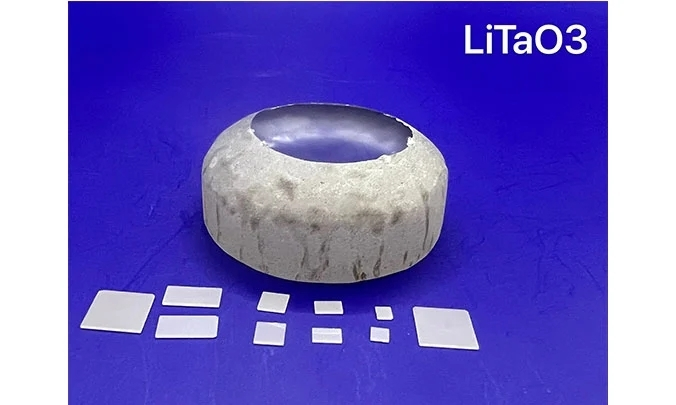Lithium tantalate (LiTaO₃) is a fascinating material with a calcite structure that crystallizes in the trigonal R3c space group. This unique crystal structure contributes to its exceptional properties and wide range of applications. In this structure, lithium ions (Li¹⁺) are bonded in a 6-coordinate geometry to six equivalent oxygen ions (O²⁻). The Li-O bond lengths vary, with three shorter bonds at approximately 2.03 Å and three longer bonds at around 2.27 Å. Tantalum ions (Ta⁵⁺) are also bonded to six equivalent oxygen ions, forming corner-sharing TaO₆ octahedra. This intricate arrangement of atoms within the crystal lattice is key to the material’s optical and electronic properties.
Lithium tantalate is a versatile material used in a variety of high-tech applications due to its unique properties. One of its primary uses is in nonlinear optics, where it is employed for frequency doubling (second harmonic generation, SHG) and optical parametric oscillation (OPO). These processes are essential in laser technology, enabling the generation of new wavelengths of light.
In addition to its optical applications, lithium tantalate is widely used in passive infrared sensors, such as motion detectors. Its pyroelectric properties make it an excellent material for detecting temperature changes, which is crucial for security systems and environmental monitoring.
Lithium tantalate is also used in terahertz generation and detection, a field that has gained significant interest for applications in imaging, spectroscopy, and communication. Its ability to generate and detect terahertz radiation makes it valuable for non-destructive testing and medical imaging.
Furthermore, lithium tantalate is a standard detector element in infrared spectrophotometers, instruments used to measure the intensity of infrared light. This application is vital in various scientific and industrial fields, including chemistry, biology, and materials science.

Quasi-phase matching (QPM) is a technique used to enhance the efficiency of nonlinear optical processes, such as second harmonic generation (SHG) and optical parametric oscillation (OPO). Lithium tantalate’s unique crystal structure and nonlinear optical properties make it an ideal material for QPM. By periodically reversing the crystal’s domain structure, QPM allows for efficient frequency conversion, enabling the generation of new wavelengths of light for various applications, including laser technology and telecommunications.
Lithium tantalate’s pyroelectric properties make it an excellent material for infrared detectors. These detectors are used in a wide range of applications, from motion sensors in security systems to environmental monitoring devices. The material’s ability to detect changes in temperature with high sensitivity makes it invaluable for these applications.
Surface acoustic wave (SAW) devices are used in various electronic applications, including filters, oscillators, and sensors. Lithium tantalate’s piezoelectric properties make it an ideal material for SAW wafers. These devices are commonly used in cell phones, televisions, and other communication devices to filter and process signals.

Lithium tantalate’s unique crystal structure and high nonlinear optical coefficients make it highly efficient for frequency conversion processes, such as second harmonic generation (SHG) and optical parametric oscillation (OPO). Its ability to generate new wavelengths of light with high efficiency is crucial for various laser applications.
Both lithium tantalate (LiTaO₃) and lithium niobate (LiNbO₃) are widely used in nonlinear optics and piezoelectric applications. While they share similar properties, lithium tantalate generally offers better thermal stability and higher resistance to photorefractive damage, making it more suitable for high-power laser applications.
Lithium tantalate’s pyroelectric properties allow it to detect changes in temperature with high sensitivity. This makes it an excellent material for infrared detectors used in motion sensors, environmental monitoring, and other applications requiring precise temperature measurement.
Yes, lithium tantalate is used in terahertz generation and detection. Its ability to generate and detect terahertz radiation makes it valuable for applications in imaging, spectroscopy, and communication. Terahertz technology is gaining interest for non-destructive testing, medical imaging, and security screening.
Lithium tantalate crystals are typically grown using the Czochralski method, a process that involves melting high-purity raw materials and slowly pulling a seed crystal from the melt. This method allows for the production of high-quality, single-crystal lithium tantalate with precise control over its composition and properties.
Lithium tantalate (LiTaO₃) is a remarkable material with a unique crystal structure and a wide range of applications. Its properties make it invaluable in nonlinear optics, infrared detection, terahertz technology, and surface acoustic wave devices. As technology continues to advance, the demand for high-performance materials like lithium tantalate will only grow, driving further innovation and discovery in various scientific and industrial fields.